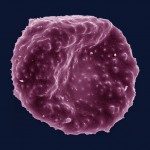Link to Pubmed [PMID] – 21191401
J. Invest. Dermatol. 2011 Apr;131(4):916-24
CD160 is expressed by human and mouse natural killer (NK) cells and other cytotoxic lymphocyte subpopulations. CD160 is mostly expressed as a trimeric 83 kDa glycosylphosphatidylinositol (GPI)-anchored activating NK receptor, cleaved upon IL-15 stimulation in a secreted trimeric soluble form (sCD160) that binds to major histocompatibility complex (MHC) class I molecules, while a transmembrane isoform appears. sCD160 exhibits immunoregulatory function as it inhibits CD8(+) T-lymphocyte cytotoxic activity. We show that human mast cells (MCs) express CD160. In human and mouse skin, resident MCs expressed CD160, whereas in C57BL/6-Kit(W-sh/W-sh) mice, CD160(+) cells were only identified at the site of reconstitution with syngeneic cultured MCs. In the human mast cell line, HMC-1, we only identified the transcripts of the GPI-anchored CD160 isoform. Furthermore, CD160 was identified in HMC-1 and mouse MC supernatants, suggesting that MCs release sCD160. Supporting this hypothesis, HMC-1 express the GPI-specific phospholipase D variant 2 involved in the NK lymphocyte membrane cleavage of CD160, and morphological studies highlighted a relative loss of CD160 expression in inflammatory skin sites, where MC degranulation is expected to occur. We also demonstrated an inhibition of T-cell cytotoxicity by HMC-1 supernatant that was partially reversed by anti-CD160 mAb. In conclusion, sCD160, produced by MCs, may have a role in T-cell-MC interactions in vivo.

